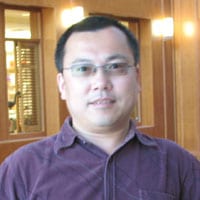Research Summary
My research interests mainly focus on gene expression regulation at the transcriptional level. We exploit methods in genetics, genomics, and bioinformatics to investigate gene regulation events in eukaryotic organisms. Currently my work is mainly related to two subfields:
1) “Gene regulation by alternative splicing and nonsense mediated mRNA decay.” Nonsense mediated mRNA decay (NMD) of unproductive splicing isoforms containing a premature termination codon has been reported as a post-transcriptional regulation of some gene families. To effectively survey the targets of NMD, we performed a genome-wide survey of NMD targets in human tissue culture cells in which NMD has been inhibited via knockdown of UPF1, a crucial component of the NMD pathway. Our results verified the activity of NMD on previously reported unproductive isoforms, confirming the precise splicing events that had been less directly inferred. Moreover, hundreds of mRNAs previously uncharacterized as potential targets of NMD were also discovered, involved in diverse functional categories. We found that various categories of splicing events can produce an unproductive isoform leading to NMD, but the largest contributor is inclusion of cassette exons. Our findings demonstrate that gene expression regulation through NMD is more widespread than previously inferred, revealing the broad functional impact of regulation by NMD.
Studies in this field are mainly performed at Prof. Steven E. Brenner’s lab. We will move forward with other organisms to examine how pervasive NMD targeted transcripts are in different species, and to characterize the evolutionary features of NMD across species.
2) “Potential molecular mechanism underlying heterosis.” Heterosis, or hybrid vigor, refers to the phenomenon that an offspring of two inbred organisms is superior to either parent, which has been long and widely utilized in crop and stock breeding. However, the underlying molecular mechanism remains unclear. To systemically survey the gene expression differences among hybrid triads and to help disclose the molecular events that may underlie heterosis, we investigated three super-hybrid rice cultivars and their parental lines across multiple development stages using rice whole-genome microarray. We found that differentially expressed genes are mostly involved in energy metabolism. Associations between these genes and the reported quantitative trait loci responsible for certain interesting agricultural traits demonstrated that differential expression of some genes between a hybrid and its parents may underlie heterosis.
Using next generation sequencing technology, we have also investigated the heritability of gene expression patterns from parents to offspring in rice hybrid triads. We discovered that most expression patterns in the hybrid are inherited from its parents. We also found hundreds of genes demonstrating significant differences between the hybrid and its parents. Our results showed that cis-action mainly contributes to gene expression in the hybrid, but the changed cis-trans interaction does affect the gene expression level in heterozygote. Comparative genomic analysis has already discovered the potential regulatory elements affecting gene expression, promising the potential of regulating gene expression by a precise method and contributing to the optimization of agronomic traits in rice.
Impact in China
Hybrid rice in China has greatly raised grain yield to feed the growing population in the past decades. Disclosing the molecular events underlying the superiority of hybrid rice may help to raise more high-yield rice. By using whole genome analysis on gene expression in rice hybrid triads, our study suggested evidence for how a hybrid strain of rice may acquire its agriculturally beneficial traits, and also provided important data to help support the discovery of the mechanistic basis underlying hybrid vigor. Further analysis of allelic expression and sequence variation from various aspects will help to clarify the regulatory elements affecting gene expression and characterize the evolutionary events causing the diversification of rice.
Awards
- China’s Top 10 Events in Basic Research in 2009, titled as “Super-hybrid Rice Heterosis Related Potential Functional Genes Identified.”
Publications
Guisheng Song, Hongli Zhai, Yonggang Peng, Lei Zhang, Gang Wei*, Xiaoying Chen, Yuguo Xiao, Zhen Zhu, Comparative Transcriptional Profiling and Preliminary Study on Heterosis Mechanism of Super-hybrid Rice, Molecular Plant, 2010, 3(6): 1012-1025. (*Co-first author)
Gang Wei, Yong Tao, Guozhen Liu, Longping Yuan, Jun Yu, Zhen Zhu, and Lihuang Zhu, A Transcriptomic Analysis of Superhybrid Rice LYP9 and its Parents. PNAS, 2009, 106:7695-7701.
Commentary: Hybrid Rice Is More than the Sum of Its Parts. Cell, 2009, 137:789-780.
Shu-Hui Song, Yue-Feng Huang, Xuan Wang, Gang Wei, Hongzhu Qu, Weiwei Wang, Song-Nian Hu, Guo-Zhen Liu, Yan-Chun Liang, Jun Yu, HRGD: a Database for Potentially Heterosis-associated Genes, Plant Molecular Biology, 2009, 69: 255-260.
Yongqin Wang, Yuguo Xiao, Yu Zhang, Chenglin Chai, Gang Wei, Xiaoli Wei, Honglin Xu, Mei Wang, Pieter B. F. Ouwerkerk and Zhen Zhu. Molecular cloning, functional characterization and expression analysis of a novel monosaccharide transporter gene OsMST6 from rice (Oryza sativa L.). Planta, 2008, 228, 525-535.
SONG Gui-sheng, ZHAI Hong-li, WEI Gang, ZHU Zhen, A Simple and Inexpensive Total RNA Extraction Method from the Rice Immature Seeds Rich in Polysaccharides, Journal of Agricultural Science and Technology, 2007, 9(4): 111-115.
